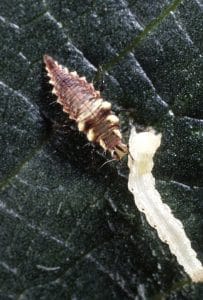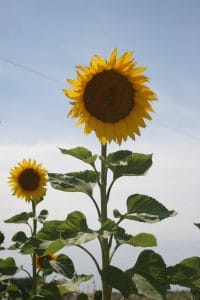It’s hard to imagine how many thousand species of bugs there are that call Elmwood Stock Farm home. Only a handful would be considered pests, in that they show up in large numbers and wreak havoc on an otherwise-stable ecosystem. Farming basically creates unique environments, like a field of corn or rows of vegetable plants not normally found in the Kentucky landscape, so we have added to that insect diversity by adding new food choices for the bugs to choose from—free of chemicals, I might add. Even the bugs eat in peace, along with us humans.

We don’t want insect pests to eat the vegetables we’re trying to grow for you, but there’s more than just that. The pests’ mouthparts also may carry microbial hitchhikers, thus transmitting disease, virus or mold invaders into the plant. Plants grown in a rich, well-balanced soil have a strong immune system and can tolerate some of this activity. Actually, when a marauding pest finds a weakened plant, it sends out pheromones announcing this ready food source to all its kin. The healthier plant is more resilient, and the pest may move along.
Bugs come in three basic categories; sap suckers, leaf eaters, or egg inserters. Sap suckers, like aphids, cucumber beetles, stink bugs or alfalfa weevils, use their elephant-trunk-like feature, called a proboscis, to pierce the stem of a plant to suck the sap to attain their nutrients—again, often bringing diseases or viruses from previous plant encounters. The mouths of the chewing insects have strong jaws and/or sturdy lips with teeth. This is the case with the little, green cabbage looper (aka the very hungry caterpillar–pictured). Egg inserters stick their ovipositors into host plants and deposit eggs, knowing when the larvae emerges from the egg, the plant will provide everything the little hatchlings need for survival. Leaves with little trails inside them from the leafminer larvae (pictured) are a strong signal that we have these types of bugs.
Bugs each have favorite foods. For example, flea beetles will make small holes in the kale, unless there are radish leaves about, in which case, the kale will go unscathed. In the spring, radishes are our barometer of how much flea-beetle pressure to expect that season. We have been known to plant “trap” crops, like radish or mizuna, to draw all the attention away from our “cash” crops. The tricky parts are how far away to plant them from each other and when to physically destroy the trap crop, bugs and all, when the trap crop becomes heavily infested.
Certified organic farmers have access to pheromone traps for some species of pests, similar to the Japanese Beetle traps you may have seen for sale. Years ago, when we had more Japanese beetles about than we do now, we hung these in the chicken and turkey pens, supplementing their diets, and I have seen them over ponds to feed fish. Some of these pheromone traps are actually mating disruptors. They attract all the males—go figure—leaving the forlorn females to lay infertile eggs or no eggs at all. Releasing infertile males is also an option, in some cases.

If the cucumber beetles (pictured) are not hurting the tender cucumber transplants (and squash, zucchini, melons, etc.—all members of the cucurbit family) when the transplants first go out, we can avoid putting the thin, woven-fabric row covers over the plants to physically keep the beetles from their favorite food. Those row covers may help pest numbers decline over time as the feeding/mating season is disrupted, but it is a lot of work for us to manage the covers, and they must come off when the plants start flowering so the bees can pollinate them to make fruits. The flowers are only open for one day, so timing is everything! Kentucky Honey’s Nick and Bev Nickels keep several-dozen hives here at Elmwood to aid in the pollination of crops.
Conventional farmers just need to identify the creature, look at a chart for what to spray, and problem solved. As organic farmers, we have learned from our elders and entomologists about insects’ life cycles. For example, under the organic regulations, we can apply Bt, a botanical solution that disrupts the digestive system of little, green or red larvae that like broccoli and kale but has absolutely no impact on the adults or any other insects, which is why it is allowed for use in organics. (Even an organic-approved substance like this is a last-resort insect-control tactic at Elmwood Stock Farm.) By knowing the life stages and cycles of common pests, we can track their development and monitor when they may surpass a certain threshold of damage, rather than maintain a state of peaceful coexistence.
All in all, the pests are predictable as to when and where they will start showing up. Often, people will be thankful for a cold winter to kill all the bugs. In this case, their onset may be delayed, but they will be back. They are resilient, and last I heard, even Minnesota has lots of bugs.
The maturity rate of bugs, plants, and larger animals to some extent, is closely correlated to “degree days,” for which we have charts. It is a more sophisticated scale of recording temperature and day length—better than average temperature. Insect eggs will not hatch until the degree-day chart matches up with their genetic code. Higher temperatures also speed up their metabolism, meaning the life cycle of the first hatch in the spring will be longer than that of their offspring that hatch in hot weather. (It works the same with other animals, too: The turkeys delay their egg laying and the barn swallows return later when we experience colder-than-normal spring weather.)

Insectivores, or insects that eat other insects, also come in the three basic types. We actually rear some of these insects to be our allies in the field. We augment the homegrown population with certain species grown by beneficial-insect farmers. For example, the larvae of the cute, little lady bug, are tiny, dinosaur-looking, voracious aphid eaters. (Aphids are a sucking pest of nearly every plant we grow.)
It is often the larval stage of beetles or bugs that eats the most because they are actively growing, compared to the adult that has a hard shell and just eats to reproduce. Another voracious larva is the offspring of the dainty, fairy-like green lacewing (pictured). She lays eggs atop a hair-like structure, because when each one hatches, it is going to devour the first thing it encounters—even its own sibling. They are also programmed to hatch at different rates, to give one time to get away in search of food, before the next one hatches. Praying mantis are the prehistoric-looking queens of the chewing family. There are hundreds of species of ground beetles that love insect eggs and the like. Spiders may be the best of all.
One of the good suckers is called the assassin bug (pictured). It can suck a caterpillar dry, leaving a leathery, little carcass. It looks very similar to a stink bug and would perish with a chemical sprayed for stink bugs, another reason we do not use harsh chemicals.
The teeny, tiny braconid wasp family may be the most valuable mercenary in our arsenal. They use their hair-like ovipositors, or egg-laying tools, to pierce the skin of an aphid or caterpillar and deposit their eggs inside. Because their life cycles are so rapid, the eggs soon hatch into hungry, teeny, tiny larvae that eat the insides of the pests before burrowing out, effectively killing the pests. This class of insects is so super sensitive to pesticide exposure, it can take years before they can take up residence after the toxins have been released.

Over the 15 or so years it took us to transition our entire farm to organic operation, we have seen the number of pest outbreaks diminish and the beneficial insects flourish. Once a farm is off the chemical treadmill, good things start to happen for the plants and for the bugs. Interestingly, we no longer see the effects of hair lice on our cattle. The Japanese Beetles stick to their preferred food, smartweed, leaving our corn silks and blackberries alone. By planting crops like sunflower and buckwheat (which have sticky nectar on the stem all season), the beneficials have a food source while waiting for their host to emerge from the shadows. By eliminating all toxic chemicals from the system, the collective good guys keep the bullies off the playground. By rotating crops, the plants develop a strong force shield themselves.
So have a little fun, go outside several times a day to see what you can see. Flip over leaves—most of all this activity is out of the direct sunlight. Stand still and see if the teeny, tiny wasps begin to move about. Mulching the soil and even some small weeds will increase housing opportunities for many of these beneficial insects to thrive. Often, insect eggs are in clusters—simply remove them. Pick the bag worms off the evergreens. But by all means, do not think you are going to win any wars with toxic chemicals. You will just have to start all over building up your army of mercenaries. —Mac Stone
(An abbreviated version of this article was printed in a previous CSA newsletter.)



Made with 
